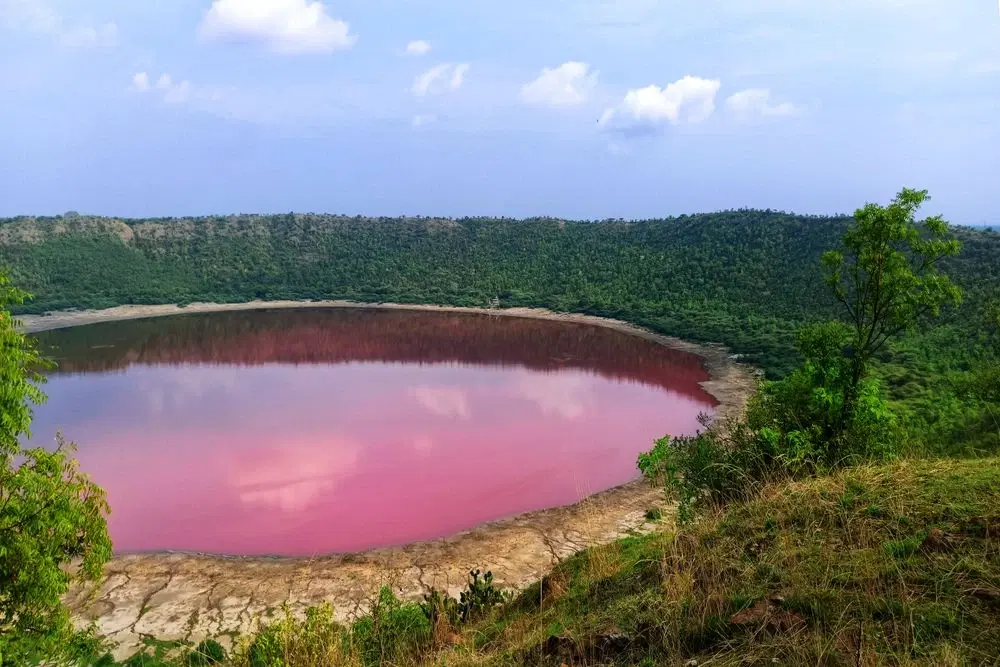
Flights
•03 min read

Crater lakes in India are not only geological marvels but also rare windows into the natural and scientific heritage of our planet. Formed by dramatic events like volcanic eruptions and meteorite impacts, these unique lakes offer stunning landscapes and captivating histories. This blog answers frequently asked questions about crater lakes in India, diving into their formation, notable locations, biodiversity, and tourism potential, so you can gain a deep understanding of these natural wonders.
Crater lakes are natural bodies of water created in depressions or basins left by explosive geological events. Most notably, they form when volcanoes erupt, leaving behind a crater that subsequently collects rainwater. Alternatively, meteorite impacts can carve out deep basins that later fill with water over millennia. The difference between volcanic crater lakes and meteorite impact lakes lies in their origin. Volcanic lakes are tied directly to the dynamic forces of Earth’s interior, while meteorite impact lakes, like the famed Lonar Lake, are remnants of celestial collisions. As per recent studies, Lonar Lake is a prime example of such a formation.
India boasts two primary types of crater lakes: those formed by volcanic activity and those resulting from meteorite impacts. Natural crater lakes formed by volcanic processes are often nestled in regions with a history of active volcanism. On the other hand, meteorite impact lakes, which are rarer, tell a more cosmic tale. Lonar Lake is a prime example of a meteorite impact lake, while Dhala Crater stands as an intriguing geological site showcasing the power of Earth’s processes.
Lonar Lake is steeped in history and mystery. Believed to have been formed around 52,000 years ago by a meteorite impact, it is the largest crater lake in India. Its saline water and unique chemical composition have drawn the attention of scientists worldwide, including researchers from leading space research agencies. The lake’s microbial life is robust and unusual, making it a natural laboratory for studying extremophiles.
Dhala Crater is another significant geological site in India. Although smaller and less known than Lonar, its distinctive features and rugged terrain make it an important subject for geological studies. Researchers continue to explore its structure and composition, which provide valuable insights into the Earth’s geological history.

Ramgarh Crater in Rajasthan holds both historical and ecological importance. With its striking landscape and surrounding attractions, it appeals to travelers eager to see a lesser-known natural wonder. The ecosystem around Ramgarh is diverse, offering visitors a glimpse into the region’s rich natural heritage.
Crater lakes in India are teeming with life, ranging from microscopic organisms to specialized plant species native to their unique environments. The microbial diversity found in these lakes, particularly in saline conditions like those of Lonar, is so distinct that it has attracted global scientific interest. This biodiversity not only differentiates crater lakes from other lakes in India but also provides key insights into evolutionary processes in isolated environments.
The ecological role of crater lakes extends far beyond their beauty. They are crucial in maintaining local environmental balance, acting as reservoirs for unique species and serving as natural laboratories for research. However, these ecosystems face threats from pollution, unchecked tourism, and climate change, emphasizing the need for vigilant environmental conservation.
Thanks to their exotic appeal and scientific significance, crater lake locations in India, such as Lonar Lake and Ramgarh Crater, attract an increasing number of visitors each year. The best times to explore these lakes vary, but early mornings and post-monsoon periods are ideal, offering clear skies and mild temperatures. Visitors can also explore nearby attractions, which provide additional historical and cultural context to the region's natural wonders.
Before planning your trip to a crater lake, it is essential to respect both the environment and local customs. Travelers are encouraged to follow sustainable tourism practices: avoid littering, minimize ecological disturbances, and engage with local guides to learn about the area’s rich cultural history. Keeping these practices in mind ensures that you contribute to the preservation of these rare geological treasures.

Did you know? Crater lakes in India offer a unique blend of geological wonders and serene landscapes, making them ideal destinations for eco-tourism and scientific exploration.
There are three major crater lakes in India: Lonar Lake, Dhala Crater, and Ramgarh Crater.
Lonar Lake in Maharashtra is the largest and most famous crater lake in India.
The three crater lakes are Lonar Lake in Maharashtra, Dhala Crater in Madhya Pradesh, and Ramgarh Crater in Rajasthan.
Lonar Lake was formed approximately 52,000 years ago due to a meteorite impact.
Crater lakes are unique due to their geological origins, saline nature, and the presence of rare microbial life forms.
Crater lakes in India are extraordinary natural features that combine geological intrigue, rich biodiversity, and tourism potential into one spectacular experience. From the meteorite impact origin of Lonar Lake to the remarkable scientific value of Dhala and Ramgarh Craters, these unique lakes not only offer breathtaking vistas but also help us understand our world's dynamic history. Preserving these natural wonders is essential for future generations, ensuring that the delicate balance of these ecosystems continues to thrive and inspire travelers and researchers alike.